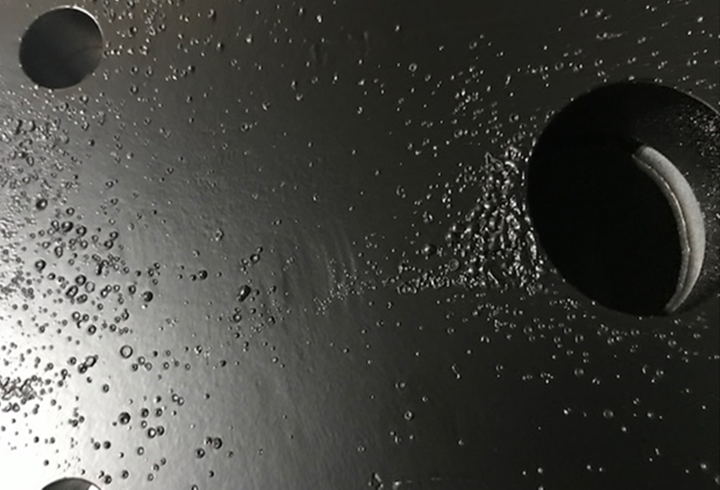Outgassing and Powder Coating Defects
Having trouble with bubbles forming during curing? Verney Denerville of TIGER Drylac discusses proper outgassing procedures.
#ask the expert

Outgassing occurs when air and or gas trapped inside castings expands during the heating process. If not properly addressed prior to the coating process, trapped gasses can result in defects.
Photo Credit: TIGER Drylac
Q: We’re having trouble with bubbles forming during the curing process for powder coated parts. Do you have any recommendations?
A. There are several potential causes for powder coating defects, especially when dealing with various substrates that exhibit porosity. The defects you describe are often caused by a phenomenon known as outgassing.
Featured Content
Common substrates are iron, steel and aluminum — metals that tend to contain minute holes or voids. This porosity can lead to outgassing during the curing process after a part has been coated. In this instance, contaminants such as trapped gasses and air are released, ultimately causing defects in the coating.
Possible outgassing defect causes
1. Castings: Gasses can become trapped in the casting material during the pouring process of both sand and die castings. These gasses can be anything from entrapped air to gas formed during the cooling of the molten metal. When a powder coating is applied over the cast metal surface, defects from outgassing can occur.
2. Galvanized (Zinc Coated) Substrates: In galvanizing, the process of applying the zinc to the steel substrate produces gasses that can be entrapped within the porosity and later released during the curing process.
3. Surface Contamination: Contamination of the surface of the substrate prior to coating is another contributing factor to outgassing. Substances such as oil, grease and other foreign materials can vaporize during the curing cycle and cause outgassing defects.
4. Coating Thickness: When the film thickness is high, it can lead to outgassing during the cure cycle.
Mitigating trapped gasses
In order to prevent defects, gasses and impurities must be expelled from the substrate prior to powder coating. It is highly recommended that the substrate be subjected to an outgassing or de-gassing process as part of the preparation for the coating application. Failure to properly outgas the substrate can lead to issues such as bumps, bubbles and pinholes — defects that will certainly lead to intercoat adhesion loss and result in rework.
Proper outgassing procedures are as follows:
- Heat the substrate to a temperature at least 15°C (30°F) higher than the part metal temperature (PMT) based on the product tactical data sheet (TDS).
- Coat the part before it cools — reaching ambient temperature introduces the possibility of air re-entering the porosity of the substrate.
- Employ proper surface cleaning procedures — parts must be free of contaminants such as oil, grease and foreign substances.
- Make sure to keep the film thickness within recommended parameters on the powder coating technical data sheet (TDS).
If the surface cannot be satisfactorily degassed at the higher temperature, using a product that is specifically formulated to assist the outgassing process, such as TIGER Drylac Outgas Forgiving/OGF Primer, during the curing cycle can help.
Additional Steps
Products that can be dry blended to the powder sample at the customer site can further help in mitigating defects caused by outgassing. While it is impossible to eliminate outgassing, the objective is to be able to reduce rework and inter-coat adhesion issues. Performing proper degassing procedures, taking cleaning measures and following the proper steps can help you take control of outgassing and keep it from wreaking havoc with your parts.
About the Author

Denerville
Photo Credit: TIGER Drylac
Verney Denerville
Verney Denerville is an application field specialist with TIGER Drylac. Visit tiger-coatings.com.
RELATED CONTENT
-
Improving Transfer Efficiencies in Coating Operations
There are many methods for addressing electrostatic grounding in metal painting processes, and Tim Ulshafer from Mueller Electric says the best method for your process is a simple and worthwhile exercise.
-
Understanding Paint Atomization
BASF coatings development expert Tim December explains how paint atomization works for both pneumatic spray applicators and high-speed rotary bell applicators.
-
Cleaning, Pretreatment to Meet Medical Specs ISO 13485 or FDA 21 CFR820
Maximilian Kessler from SurTec explains new practices for industrial parts cleaning, metal pretreatment and decorative electroplating in the medical device industry.


















